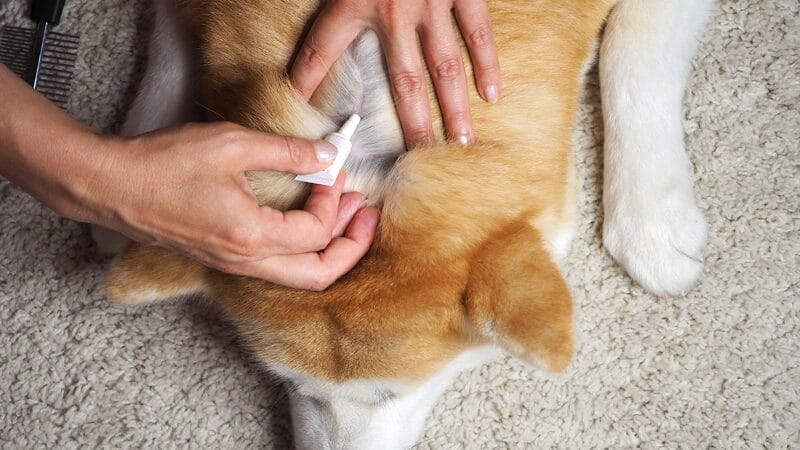
What You Should Know About Flea Product Toxicity in Dogs and Cats
Fleas are a common parasite that feeds on your pet’s blood, causing them to itch. Learn about flea product toxicity in dogs and cats.
Fleas are a common nuisance for both cats and dogs, feeding on their blood and causing itching and discomfort. More importantly, fleas can transmit infectious diseases, such as cat scratch fever, which can affect humans. Fortunately, there are safe and effective products available to protect our pets from fleas, ticks, and other ectoparasites. It’s best to use these products year-round to ensure continuous protection. When used correctly, they are safe and effective, but misuse can lead to serious health issues for your pets.
Prevention of Flea Control Product Toxicity in Dogs and Cats
Before applying or administering a flea control product to your pet for the first time, consult your family veterinarian. They can provide the best recommendations for your pet and help you navigate the various options available.
Dos and Don’ts for Flea Control Products
Dos:
- Use a veterinarian-prescribed or recommended flea control product. This ensures that the product is safe and effective for your pet.
- Read label directions carefully and follow them. Proper application is key to avoiding toxicity.
- If the product was applied topically, separate pets in a multi-pet household until the flea control product is completely dry. This prevents pets from licking the product off each other, which can be harmful.
- Store flea control products in a secure location. Keep them away from children and pets to avoid accidental exposure.
Don’ts:
- Don’t use flea control products on young puppies, kittens, or pregnant or nursing pets without consulting your veterinarian. Most products have a minimum age requirement listed on the label.
- Don’t apply a topical flea control product to skin that is red, irritated, scratched, or broken. This can increase the risk of absorption and toxicity.
- Don’t use more than one flea control product on your pet at a time unless prescribed by your veterinarian. Combining products can lead to an overdose.
- Don’t apply a flea control product designed for dogs to a cat. Dogs and cats have different sensitivities to certain ingredients, and using the wrong product can be dangerous.
Toxicities and adverse reactions to flea control products are typically listed on the label. If you have any questions, discuss them with your veterinarian or their knowledgeable care team.

Signs of Flea Control Product Toxicity in Cats and Dogs
Flea product toxicity occurs when a pet ingests or absorbs a toxic amount of the active ingredients in flea control products. These products can include topical treatments, oral medications, collars, and sprays. The active ingredients, such as pyrethrins, pyrethroids, and organophosphates, are designed to kill fleas but can be harmful to pets if they are exposed to too much of them.
Flea control product toxicity is rare but can occur, especially when a product intended for dogs is used on a cat. Signs can appear within one to 12 hours after application and may vary depending on the type of product and the ingredients involved. Cats are particularly sensitive to the toxic effects of pyrethrums and organophosphates, so extra caution is needed when using these products on felines.

The most common signs of toxicity from pyrethrum-based flea products are muscle tremors and excessive salivation. Common signs of organophosphate-based flea product toxicity include diarrhea, vomiting, difficulty breathing, small pupils, muscle tremors, weakness or falling over, and drooling. Organophosphate toxicity can be rapidly fatal, depending on the ingredients and the dose to which your pet is exposed.
What to Do if Your Dog or Cat Has Flea Control Product Toxicity
- Remove the pet from the source of the toxin immediately. If the product was applied topically, wash your pet with warm water and a mild dishwashing liquid, such as Dawn®. This helps remove the product from their skin.
- Contact your family veterinarian immediately or bring your pet to the nearest MedVet veterinary emergency clinic. They can provide guidance and necessary treatment.

Common Flea Control Products
There are numerous flea and tick control products available, and it’s important to read the labels and consult your veterinarian to determine the best option for your pet. Here are some common and effective products:
- Isoxalaners: Nexgard, Bravecto and Simparica
- Fipronil: Frontline Plus and its variations (over-the-counter)
- Imidacloprid: Advantage and its variations, K9 Advantix and its variations (for dogs only)
- Selamectin: Revolution (FDA-approved for sarcoptic mange in dogs), and Revolution Plus (for cats)
- Seresto Collars: Recommended for food-allergic pets or those with epilepsy. Also useful when a topical or oral flea prevention product cannot be used.
- Lufenuron: Found in Sentinel for dogs. Acts as a growth regulator and is very beneficial in a comprehensive flea control program.
Flea product toxicity is a serious concern for pet owners, but with the right knowledge and precautions, it can be prevented. By being aware of the signs, taking immediate action, and seeking veterinary care when necessary, you can help ensure your pet remains safe and healthy. Always choose flea products that are specifically designed for your pet’s species and age, and consult your veterinarian for guidance.
Visit our Pet Care Resources library for more pet health and safety information.
FAQs
Is it safe to use a flea and tick preventative for my pet?
What are common signs of toxicity from flea and tick products?
What should I do if my dog or cat has flea control product toxicity?
Contact MedVet
If you suspect your pet has flea control toxicity, contact a veterinarian.
Find a MedVetContents
Contact MedVet
If you suspect your pet has flea control toxicity, contact a veterinarian.
Find a MedVet


